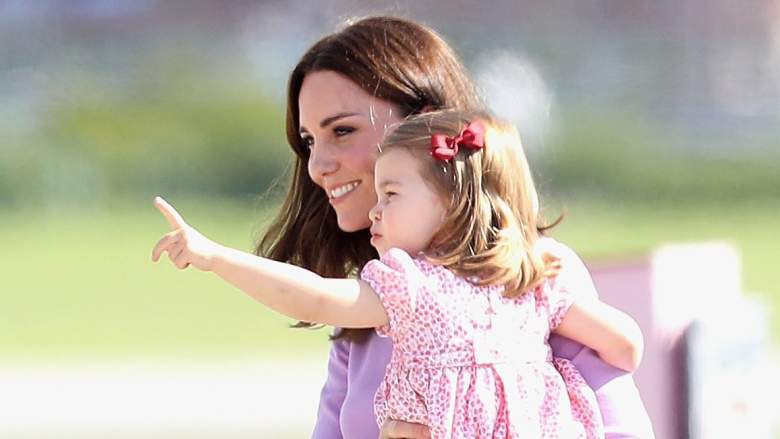
Getty Catherine, the Duchess of Cambridge, with Princess Charlotte in Germany in July 2017.
A major change has been made to the British Line of Succession with the announcement Monday that Prince William and Kate Middleton, the Duchess of Cambridge, are expecting their third child. The baby will be fifth in line to the throne, no matter his or her gender.
This not only moves Prince Harry further down the line, but it could also be the first time the new Succession to the Crown Act of 2013 makes an impact on the line. The Line of Succession determines who becomes King or Queen after Queen Elizabeth II.
On Monday, the Royal Family announced that Kate is expecting her third child. Since Kate previously suffered from Hyperemesis Gravidarum during her last two pregnancies, her health is being closely monitored at Kensington Palace. Kate is also clearing her schedule, and could not attend an event at the Hornsey Road Children’s Centre in London.
Prior to today, William’s younger brother Harry was fifth in the line of succession, following his father Prince Charles, William and William’s two children. Now, Harry moves down another rung to sixth.
Notably, even if William and Kate’s new child is a son, he will not kick Princess Charlotte down a rung. This is thanks to the new Succession to the Crown Act of 2013, notes the BBC. Although the U.K. Parliament passed it in 2013, it didn’t go into effect until the remaining British Commonwealth countries where Queen Elizabeth II is Head of State (like Canada, Australia and New Zealand) also passed the act. In 2011, a rule that barred women from becoming Queen if a King doesn’t have sons was struck down.
It gets rid of longstanding British tradition of giving male royalty preference over female royalty. Had the act not been passed and if Charlotte had a younger brother, he would take preference over her. However, the act does not retroactively change the line of succession, so Princess Anne, The Princess Royal did not jump ahead of her younger brothers, the Duke of York and Earl of Wessex.
The new act also allows the Royal Family to marry a Roman Catholic, although he or she cannot become monarch. It also negated the Royal Marriages Act of 1772, which required the Queen (or King) to give consent to all members of the Royal Family to marry. Now, she only has to do so for the first six in the line of succession. In other words, everyone after Prince Harry can marry without the Queen’s permission. It’s great news for Princess Beatrice.

GettyPrince Charles is at the top of the line of succession, followed by his son Prince William. Harry is now sixth in the line.
Here is the full line of succession, from the Royal Family website, including Prince Harry and Duchess Kate’s new child.
1. Charles, The Prince of Wales (Queen Elizabeth II’s eldest child)
2. William, The Duke of Cambridge (Prince Charles’ eldest child)
3. Prince George of Cambridge (Prince William’s eldest child)
4. Princess Charlotte of Cambridge (Prince William’s second child)
5. Prince William & Duchess Kate’s new baby (Prince William’s third child)
6. Prince Henry (“Harry”) of Wales (Prince Charles’ second child)
7. Prince Andrew, The Duke of York (Queen Elizabeth II’s second child)
8. Princess Beatrice of York (Prince Andrew’s eldest child)
9. Princess Eugenie of York (Prince Andrew’s second child)
10. Prince Edward, The Earl of Wessex (Queen Elizabeth II’s fourth child)
11. James, Viscount Severn (Prince Edward’s child)
12. The Lady Louise Mountbatten-Windsor (Prince Edward’s child)
13. Princess Anne, The Princess Royal (Queen Elizabeth II’s child)
14. Mr. Peter Phillips (Princess Anne’s child)
15. Miss Savannah Phillips (Peter Phillips’ child)
16. Miss Isla Phillips (Peter Phillips’ child)
17. Zara Phillips, Mrs. Michael Tindall (Princess Anne’s child)